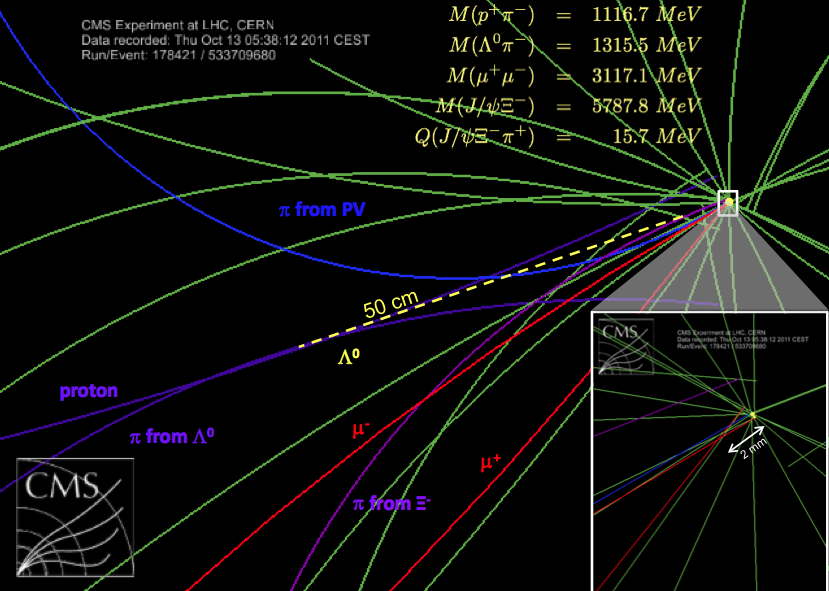
The CMS experiment has submitted a paper for publication describing the first observation of a new, excited bottom (or beauty) baryon known as the Ξ*b0, with a statistical significance of more than 5 standard deviations (5σ) above the expected background. The mass is measured to be 5945.0 ± 2.8 MeV.
The observation was made in a data sample of proton—proton collisions delivered in 2011 by CERN's Large Hadron Collider (LHC) operating at a centre-of-mass energy of 7 TeV. The sample corresponds to an integrated luminosity of 5.3 fb-1[1].
Expectations of the Standard Model of Particle Physics
The well-established quark model predicts the existence of so-called Ξb baryons containing one beauty (b) quark, one strange (s) quark, and either an up (u) quark, which results in a neutral Ξb0 baryon, or a down (d) quark, which results in a charged Ξb- baryon. These may exist with various values of the quantum numbers for angular momentum (J) and parity (P). The ground-state, lowest-mass Ξb baryons — both charged and neutral — have been previously observed.
None of the predicted excited states have ever been seen, including the Ξ*b0 state (with JP=3/2+), which is expected to break up rapidly in a cascade of decays to lower mass particles.
Experimental technique
CMS searched for the Ξ*b0 decaying as follows (including implicitly also the charge conjugate states) :
- Ξ*b0 → Ξb- π+, (this first pion is "prompt"), followed by the subsequent decay:
- Ξb- → J/ψ Ξ- followed by:
- J/ψ → μ+μ- and Ξ- → Λ0π- and finally:
- Λ0 → p+π-.
The cascade of decays above leads to one proton, two muons, and three pions. The existence of the Ξ*b0 is established by detecting all of these particles and measuring the charge, momentum and point of creation ("vertex") for each one. Figure 1 shows a typical event display for a candidate Ξ*b0 decaying via the decay sequence above (and as shown in Figure 2.).
The Λ0 → p+π- decay is reconstructed as two oppositely charged tracks, forming a vertex that is displaced from the primary vertex — the initial proton proton collision point — due to the long Λ0 lifetime, τ (cτ(Λ0) = 78.9 mm). The invariant mass of tracks must be consistent with the Λ0 mass. Next, the Ξ- is reconstructed by finding combinations of a Λ0 and a π- track that are consistent with the mass of the Ξ-. Similarly, pairs of oppositely charge muons are sought that have an invariant mass consistent with the mass of the J/ψ. Backgrounds due to random combinations of particles are reduced by requiring decay products to be displaced from the primary vertex, as is expected due to the long lifetimes of the parent particles in the decay chain: cτ(Ξ-) = 49.1 mm and cτ(Ξb-) = 0.47 mm.
The Ξb- is then reconstructed by combining the J/ψ and the Ξ-. Figure 3 shows the invariant mass of the J/ψ Ξ- pairs. There is a clear signal peak of 108 ± 14 events above background. The Ξb- mass is measured to be 5795.0 ± 3.1 (stat) MeV, in good agreement with the world average value of 5790.5 ± 2.7 MeV. The background model is constructed from the data using candidates where the pion from the Ξ- and the proton have the same charge.
The Ξ*b0 is expected to decay promptly via the strong interaction, therefore candidates were sought by combining the reconstructed Ξb- with a prompt π+ that is consistent with coming from the primary vertex. The existence of the Ξ*b0 should manifest itself as a peak in the invariant mass of the Ξb- and the π+. However, to partially cancel measurement errors and hence increase the sensitivity, the quantity Q = M(J/ψΞ-π+) - M(J/ψΞ-) -M(π) is considered instead. Figure 4 shows the Q distribution for the full CMS data sample. The 21 events observed in the region 12—18 MeV represent a clear excess with respect to the expected background of 3.0 ± 1.4 events. The difference between the mass of the new b baryon and the sum of the masses of the Ξb- and the π+ is measured to be Q = 14.84 ± 0.74(stat) ± 0.28(syst) MeV.
Statistical Significance of the Observation
The signal significance was evaluated to be 6.9σ by considering the probability that the background, in the absence of any signal, could fluctuate as high or higher than the CMS observation. We take into account the Look Elsewhere Effect [2] by searching for a peak in the mass range 0 < Q < 50 MeV, where the Ξ*b0 is theoretically expected. The resulting background fluctuation probability is p = 1.3 x 10-8, which corresponds to a 5.7σ equivalent Gaussian significance. If the search range is (very conservatively) extended to 0 < Q < 400 MeV, the signal significance becomes 5.3σ.
The mass of the new b baryon is measured to be 5945.0 ± 2.8 MeV, where the error is dominated by the uncertainty in the world-average mass of the Ξb-. The width is not measured with good statistical precision but the signal shape is compatible with theoretical expectations. Due to the way it decays and the measured mass, the new baryon is likely to be the Ξ*b0 baryon, with JP=3/2+.
[1] http://news.stanford.edu/news/2004/july21/femtobarn-721.html
[2] http://cmsexperiment.web.cern.ch/news/should-you-get-excited-your-data-…
- Log in to post comments

